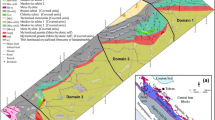Abstract
Karst rocky desertification is one of the major ecological and environmental problems that threaten the sustainable development of southwestern China. This study focuses on a case study of the small watershed in Chenqi where karst rocky desertification is particularly severe. This paper considers samples of soils from six different land use patterns in Chenqi village. Various correlations are observed by using fractal theory, including an emerging model for studying soil aggregates. This study demonstrates how the fractal characteristics of soil structure and the stability of soil aggregates are crucial to better understanding karst rocky desertification. The fractal dimension of different land use patterns can be used to indicate the magnitude of soil destruction. Soil fractal dimension can be applied using different methods to characterize the changes in factors influencing the stability of soil structure. The results indicate a significant negative relationship between fractal dimension of soil aggregates and large aggregate content (of diameters 5–10 mm) and a significant positive relationship between fractal dimension and micro-aggregate content (<0.25 mm). The fractal dimension of soil aggregates is also significantly negatively correlated with both clay content and organic matter content. These results suggest that fractal dimension can be used as a reliable indicator of soil quality and presents advantages compared to using mean weight diameter.











Similar content being viewed by others
References
Burrough P (1981) Fractal dimensions of landscapes and other environmental data. Nature 294(5838):240–242
Crawford J, Verrall S, Young I (1997) The origin and loss of fractal scaling in simulated soil aggregates. Eur J Soil Sci 48(4):643–650
Fredlund DG, Hahardjo H (1993) Soil mechanics for unsaturated soils. Wiley, New York, p 517
Fu WL, Zhang ZW, Zhang H, Xia KS, Xie DT, Ni JP (2007) Study on characteristics of soil erosion on Karst Hillslope. Soil and Water Conserv 21(5):38–41 (in Chinese)
He X, Xiong KN, Chen HY, Hu SG (2008) Research of soil properties during rocky desertification process of ecological management district in karst mountainous areas. Yunnan Normal Univ 28(2):58–64 (in Chinese)
He YB, Zhang XB, Wen AB (2009) Discussion on karst soil erosion mechanism in karst mountain area in southwest China. Ecol Environ Sci 18(6):2393–2398 (in Chinese)
Huang GH, Zhan WH (2002) Fractal property of soil particle size distribution and its application. Acta Pedol Sin 39(004):490–497 (in Chinese)
Li YB, Wang SJ, Tan Q, Long J (2006) Research development and problems of karst rocky desertification. Earth Environ 34(3):9–14
Liu MY, Chang QR, Qi YB (2006) Fractal features of soil aggregate and microaggregate under different land use. Sci Soil Water Conserv 4(4):47–51 (in Chinese)
Long J, Deng QQ, Jiang XR, Li YB, Yao B (2005) Effects of land use types on restoration of soil quality on karst rocky desertification region in Guizhou province. Acta Ecologica Sinica 25(12):3188–3195 (in Chinese)
Long J, Li J, Deng QQ (2006) Soil properties and fractal features in the rocky desertification process of karst regions, Guizhou province. Chin J Soil Sci 37(4):635–639 (in Chinese)
Perfect E, Kay B (1995) Applications of fractals in soil and tillage research: a review. Soil Tillage Res 36(1–2):1–20
Qi YC, Wang YY, Liu J (2011) Quality evaluation of soil aggregates with different land use patterns. Acta Agriculturae Boreali-occidentalis Sinica 20(10):187–191 (in Chinese)
Rieu M, Sposito G (1991) Fractal fragmentation, soil porosity, and soil water properties: I. Theory. Soil Sci Soc Am J 55:124
Su J, Zhao S-W (2009) Comparison of the analysis methods for soil aggregate stability. Sci Soil Water Conserv 29(5):114–117 (in Chinese)
Tang YQ, Ye WM, Huang Y (2001) Full-filled-reviving karst cave—the development characteristics of YiXing Muli cave. Hydrogeol Eng Geol 5:39–42 (in Chinese)
Turcotte D (1986) Fractals and fragmentation. J Geophys Res 91(B2):1921–1926
Tyler SW, Wheatcraft SW (1992) Fractal scaling of soil particle-size distributions: analysis and limitations. Soil Sci Soc Am J 56:362–369 (USA)
Wang SJ, Li YB (2007) Problems and development trends about researches on karst rocky desertification. Adv Earth Sci 22(6):573–581 (in Chinese)
Wang QK, Wang SL (2005) Forming and stable mechanism of soil aggregate and influencing factors. Chin J Soil Sci 36(3):415–419 (in Chinese)
Wang DL, Zhu SQ, Huang BL (2003) Primary study on soil physical and chemical properties in rocky desertification process. Mountain Agric Biol 22(3):204–207 (in Chinese)
Wang SJ, Li RL, Sun CX, Zhang DF, Li FQ, Zhou DQ, Xiong KN, Zhou ZF (2004a) How types of carbonate rock assemblages constrain the distribution of karst rocky desertified land in Guizhou Province, PR China: phenomena and mechanisms. Land Degrad Dev 15:123–131
Wang SJ, Liu QM, Zhang DF (2004b) Karst rocky desertification in southwestern china: geomorphology, land use, impact and rehabilitation. Land Degrad Dev 15:115–121
Wu TZ, Hong W (1999) Study on fractal features of soil aggregate structure under different management patterns. Acta Pedol Sin 36(002):162–167 (in Chinese)
Yang PL, Luo YP (1993) Characterization of soil fractal features using weight distribution. Chin Sci Bull 38(020):1896–1899 (in Chinese)
Yang P, Tang YQ, Zhou NQ, Wang JX, She TY, Zhang XH (2011) Characteristics of red clay creep in karst caves and loss leakage of soil in the karst rocky desertification area of Puding County, Guizhou, China. Environ Earth Sci 63:543–549
Young I, Crawford J (1991) The fractal structure of soil aggregates: its measurement and interpretation. J Soil Sci 42(2):187–192
Young I, Crawford J, Rappoldt C (2001) New methods and models for characterising structural heterogeneity of soil. Soil Tillage Res 61(1–2):33–45
Acknowledgments
The investigation was supported by the National Key Technologies R&D Program of China through Grant No. 2012BAJ11B04 and the National Natural Science Foundation of China (Grant No. 41072204) and Shanghai Leading Academic Discipline Project (project No. B308) and also funded by Kwang-Hua Fund for College of Civil Engineering, Tongji University. The authors are deeply indebted to the three financial supporters.
Author information
Authors and Affiliations
Corresponding author
Rights and permissions
About this article
Cite this article
Tang, Y., Li, J., Zhang, X. et al. Fractal characteristics and stability of soil aggregates in karst rocky desertification areas. Nat Hazards 65, 563–579 (2013). https://doi.org/10.1007/s11069-012-0383-2
Received:
Accepted:
Published:
Issue Date:
DOI: https://doi.org/10.1007/s11069-012-0383-2




